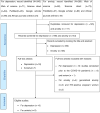Depression and anxiety among pregnant women during COVID 19 pandemic in Ethiopia: a systematic review and meta-analysis
- PMID: 39691679
- PMCID: PMC11649664
- DOI: 10.3389/fgwh.2024.1453157
Depression and anxiety among pregnant women during COVID 19 pandemic in Ethiopia: a systematic review and meta-analysis
Abstract
Background: Coronavirus Disease-19 pandemic had an adverse impact on the mental health of the public worldwide, but the problem is worst among pregnant women due to social distancing policies and mandatory lockdown, including prenatal care services. As a result, the prevalence of depression and anxiety could increase during the pandemic, particularly among pregnant women. Thus, the purpose of this review is to determine the magnitude of depression and anxiety and contributing factors among pregnant women during the pandemic in Ethiopia.
Methods: Web of Science, Since Direct, PubMed, Google Scholar, and African Journals Online were the electronic databases searched, the Preferred Reporting Items for Systematic Reviews and Meta-Analyses (PRISMA) reporting guidelines were followed in this review. The Newcastle-Ottawa Critical Appraisal Checklist was used to assess the quality of the included studies. A predefined data extraction sheet developed in Excel was used to extract the data. The pooled prevalence of anxiety and depression was determined by a random effect model meta-analysis.
Results: 4,269 and 1,672 pregnant women were involved in depression and anxiety studies, respectively. The pooled prevalence of depression and anxiety among pregnant women during the COVID-19 pandemic in Ethiopia was 24.7% (95% CI: 18.52-30.87) and 35.19% (95% CI: 26.83-43.55), respectively. Single marital status (AOR = 2.22, 95% CI: 1.07-3.37), poor social support (AOR = 2.7, 95% CI: 1.06-4.35), unplanned pregnancies (AOR = 2.17, 95% CI: 1.34-3.0), and unsatisfied marital status (AOR = 2.16, 95% CI: 1.17-3.14) were risk factors for depression. Violence against intimate partners (AOR = 2.87, 95% CI: 1.97-3.77) and poor social support (AOR = 1.98, 95% CI: 1.24-2.71) were risk factors for anxiety.
Conclusion: One-fourth and nearly one-third of pregnant women had depression and anxiety, respectively, during COVID-19 pandemic in Ethiopia. Single or unsatisfied marital status and unplanned pregnancies were risk factors for depression. Poor social support was significantly associated with depression and anxiety. Pregnant women who experienced violence against intimate partners had higher anxiety. After COVID-19 pandemic, mental health interventions are essential for reducing depression and anxiety.
Systematic review registration: https://www.crd.york.ac.uk/prospero/display_record.php?RecordID=527148, PROSPERO (CRD42024527148).
Keywords: COVID 19 pandemic; Ethiopia; anxiety; depression; pregnant women.
© 2024 Gebeyehu Wondmeneh and Wogris.
Conflict of interest statement
The authors declare that the research was conducted in the absence of any commercial or financial relationships that could be construed as a potential conflict of interest.
Figures














Similar articles
-
Poor sleep quality and suicidal ideation among pregnant women during COVID-19 in Ethiopia: systematic review and meta-analysis.PeerJ. 2023 Sep 29;11:e16038. doi: 10.7717/peerj.16038. eCollection 2023. PeerJ. 2023. PMID: 37790617 Free PMC article.
-
Sleep disturbance and its associated factors among pregnant women in Ethiopia: systematic review and meta-analysis.BMC Psychiatry. 2024 Jan 15;24(1):51. doi: 10.1186/s12888-023-05456-7. BMC Psychiatry. 2024. PMID: 38225632 Free PMC article.
-
Intimate partner violence and associated factors among women during the COVID-19 pandemic in Ethiopia: a systematic review and meta-analysis.Front Glob Womens Health. 2024 Aug 23;5:1425176. doi: 10.3389/fgwh.2024.1425176. eCollection 2024. Front Glob Womens Health. 2024. PMID: 39246731 Free PMC article. Review.
-
Depression and insomnia among healthcare professionals during COVID-19 pandemic in Ethiopia: a systematic review and meta-analysis.PeerJ. 2023 Mar 21;11:e15039. doi: 10.7717/peerj.15039. eCollection 2023. PeerJ. 2023. PMID: 36967998 Free PMC article.
-
Depression, anxiety and stress among HIV-positive pregnant women in Ethiopia during the COVID-19 pandemic.Trans R Soc Trop Med Hyg. 2023 May 2;117(5):317-325. doi: 10.1093/trstmh/trac126. Trans R Soc Trop Med Hyg. 2023. PMID: 36579933
References
Publication types
LinkOut - more resources
Full Text Sources
Research Materials

